|
Topeka Municipal Auditorium
Topeka, KS
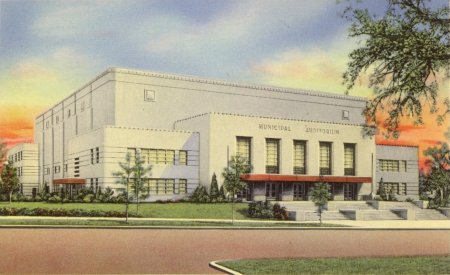
Postcard of the Topeka Municipal Auditorium - ca.1950s
courtesy eBay
The Topeka Municipal Auditorium in Topeka, Kansas was built on land
originally owned by
Colonel George W. Veale who at his Victorian home
there, had entertained President Ulysses S. Grant and every Governor and
United States Senator from Kansas from the time the state was admitted
to the Union. In the late 1800's, the land was acquired, the home
leveled, and a two-story brick building was constructed that
housed an auditorium, a fire station and city offices.1
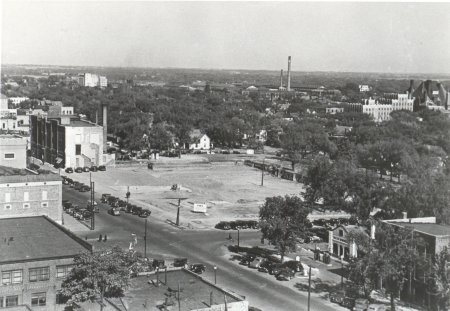
8th and Quincy just prior to starting construction of Municipal Auditorium
- 1937
Photo courtesy Brea Black - Topeka and
Shawnee County Public Library
In the late 1930s the Federal Public Works Agency (PWA) approved a grant
for the City of Topeka for nearly $7,000,000 for construction of a town
hall. Designs for city offices were added to the north side of the
structure. Contracts for the building were awarded to F. M. "Earl"
Spencer, general contractor, A. Tucker Electric Co. for wiring, and U.S.
Engineering Co. of Kansas City for plumbing, heating and ventilation.1
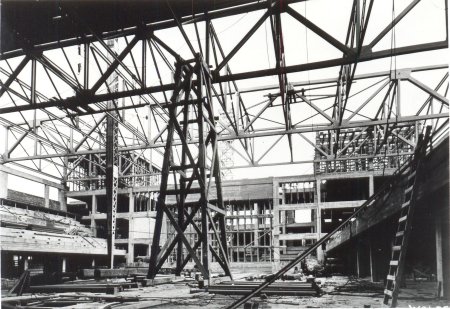
Municipal Auditorium under construction - 1939
Photo courtesy Brea Black - Topeka and
Shawnee County Public Library
The building, which took three years to complete, used over one mile of
bricks, steel weighing two million pounds, concrete to pave 5.5 miles of
highway and enough plaster to cover seven blocks. There were 303
windows, and 420 doors. The building could be evacuated within two
minutes. Safety was a prime factor for the Auditorium stage. In case of
fire, the asbestos fire wall could be dropped in seconds. An orchestra
lift measuring 50 feet by nine feet was one of only eight such lifts
then in use in the United States.1
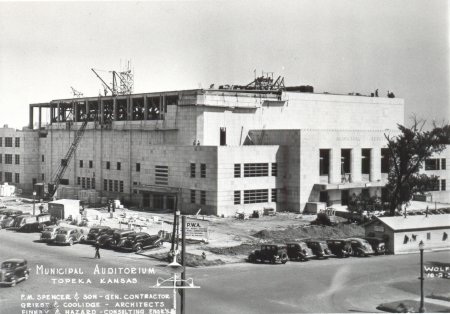
Municipal Auditorium under construction - 1939
Photo courtesy Brea Black - Topeka and
Shawnee County Public Library
The construction suffered from delays, but finally on May 12, 1940, a
standing-room-only crowd gathered by representatives from churches
throughout the city to dedicate the new building. The celebration
continued the following day with a parade that included floats, bands,
drill corps and 6,000 school children.1
The first road performer was Paul Whiteman and his orchestra; tickets
for the performance were $2 a couple. Festivities continued for a week.
The grand finale drew 8,000 more people than could be seated in the
4,200 seat arena. The musical revue was broadcast over WIBW radio for
those who didn't get to see the show.1
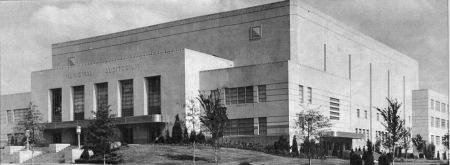
The Topeka Municipal Auditorium
Photo courtesy Brea Black - Topeka and
Shawnee County Public Library
Centrally located in the heart of downtown Topeka just one block from
the main business district, the auditorium provided the easy
accessibility. Immediately adjacent to the building were parking
facilities for 450 cars - and within a two block area, ample space is
available for an additional 1500 cars.2
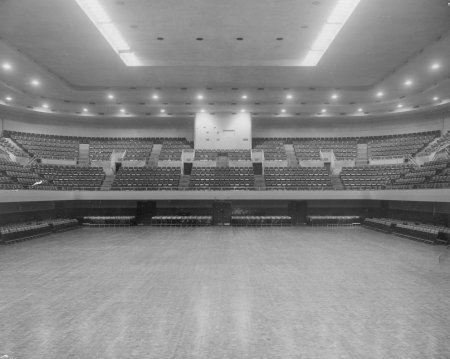
Original interior of the Topeka Municipal Auditorium - ca.1950s
Photo courtesy Erin Aldridge and the Topeka Performing Arts Center
The main arena could be employed either as an open floor for dancing,
sports or exhibition displays or utilized for audience seating for over
4200 people. The balcony in the auditorium sat 2114 and the main floor
2132.2
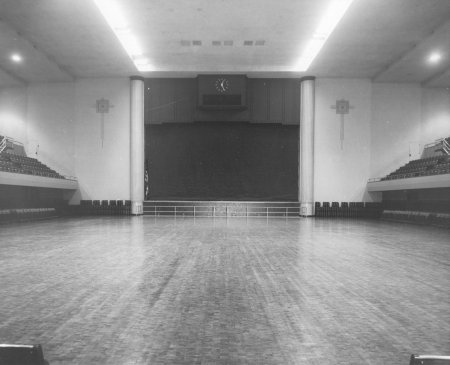
Original interior of the Topeka Municipal Auditorium - ca.1950s
Photo courtesy Erin Aldridge and the Topeka Performing Arts Center
The stage had an elevating section, which enabled special effects to be arranged, and also permitted
easy handling of all types of exhibits. Storage space was available
for handling properties and equipment as was available a public address
system for the arena, exhibition hall and assembly room. An electric organ, grand
piano and 35mm movie projectors and spotlights were also available.2

1500 seat banquet area - ca.1950s
Photo courtesy Brea Black - Topeka and
Shawnee County Public Library

spacious modern kitchen - ca.1950s
Photo courtesy Brea Black - Topeka and
Shawnee County Public Library
The Auditorium Building was air conditioned throughout and provided well arranged space for all types of
meetings and gatherings, large or small. The kitchen enabled
preparation of meals for over 1500 people at one time.2

450 seat assembly room with a small stage - ca.1950s
Photo courtesy Brea Black - Topeka and
Shawnee County Public Library
A battery of committee rooms were available for private meetings, with
six rooms seating 50 people and three rooms seating 150 people. In
addition, a private business office was also available during large scale
conventions.2
Many Topekans received their high school diplomas on its stage, and some
took the Kansas Bar Exam in its basement. The facility housed the
community Thanksgiving dinner and the Junior League Next-to-New sale.1

The Kansas River flooding overrunning Topeka homes and
businesses - July 13, 1951
Topeka Capital-Journal Photo courtesy
NOAA
During the
1951 Topeka Flood, the largest concentration of about 1,500, were fed, entertained and bedded down in the Municipal Auditorium, the emergency relief headquarters. The situation, which had resembled a fairly orderly dormitory Wednesday night when only North Topeka's and Shunganunga evacuees were on hand, turned into organized confusion Thursday evening as hundreds of Oakland and East Topeka residents registered for aid. By mid-afternoon, the auditorium facilities were taxed to the limit, and the 500-cot station at the Masonic Temple Building was full.1

A full auditorium - ca.1950s
Photo courtesy Brea Black -
Topeka and Shawnee County Public Library
On May 21, 1956, after performing the night before in
Omaha, Nebraska, Elvis, Scotty, Bill and
DJ performed at the Municipal Auditorium. While Elvis had flown,
the band had driven the roughly 168 miles south down US 75.
  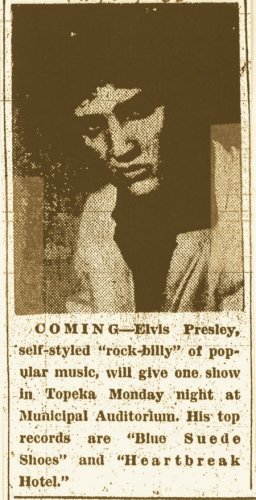
Ad in the Daily Capital - May 20, 1956
courtesy Topeka and
Shawnee County Public Library
Ads for the show in the city's two newspapers, the
Topeka Daily Capital and the Topeka State Journal, ran almost daily
as early as the 15th though apparently it wasn't enough to fill the
house. On the day after the show, the Daily Capital
reported:
That teenage trauma Elvis Presley had about 2,500 Topeka misses envying a microphone Monday night in Municipal Auditorium.3
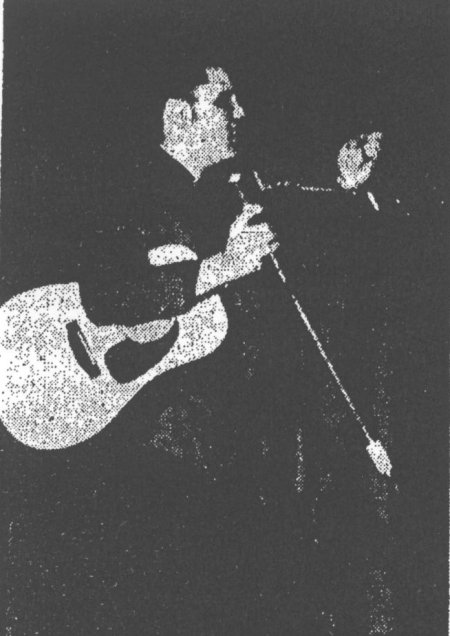
Elvis at the Topeka Municipal Auditorium - May 21, 1956
Daily Capital Photo courtesy Topeka and
Shawnee County Public Library
The rock-and-roll recording sensation strode onto the stage like a musical Paul Bunyan with a guitar for an axe.
And for 20 minutes, he made love to the "mike," completely felling most of his already-sold audience.
Anticipating demonstrations similar to those in other cities, Topeka police took no chance.
Several stood at stage-side through Presley's short performance which followed a variety show.
But the guards were not needed. The stage was too high and Presley was out of the building by a secret exit and into the Hotel
Kansan before the youths caught on.3
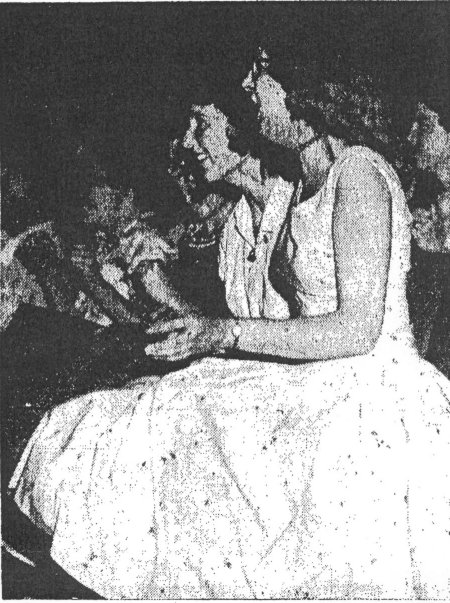
Fans watch Elvis at the Topeka Municipal Auditorium - May
21, 1956
Daily Capital Photo courtesy Topeka and
Shawnee County Public Library
It was a little hard to be sure above the continuing squeals and
clapping—but the sensuous 21-year·old from Memphis apparently sang some of the songs which have pushed him to the top of the Hit Parade.
Though he didn‘t give the titles, it was obvious the young fans had heard the loud tunes before.
Heartbreak Hotel," "Blue Suede Shoes," "Money Honey," and "Hound Dog" were among them.
With movements which would put a burlesque queen to shame, Elvis squirms out his songs. He keeps himself so breathless from the physical contortions that the pleasant timbre of his lower baritone notes can seldom be detected.
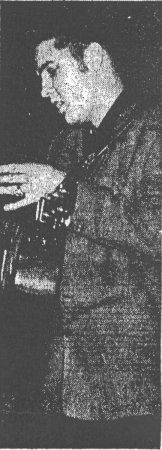 "He puts everything into it," is the way a Hayden High senior girl aptly explained it.The initiated comes away in awe that this ex-trunk driver's records sell by the millions without benefit of visual aids.
"He puts everything into it," is the way a Hayden High senior girl aptly explained it.The initiated comes away in awe that this ex-trunk driver's records sell by the millions without benefit of visual aids.
Before he sang "Blue Suede Shoes," he told the youthful crowd that "'this song we kind of dread, because when we get through, we have just about had it."
Dressed in his famed red coat and black shirt and pants, Elvis has the effect of an earlier Frank
Sinatra, with a more robust appeal.
His songs not only transform his fans, but that walk on stage apparently brings a metamorphosis in him.
Off stage. despite some published reports, Elvis is a polite young man, who prefixes nearly every sentence with
"Yes, mam," or "Thank you, mam."
With a hair cut and a shave for his sideburns. he would not turn many heads on Kansas Avenue. His light brown hair tops very blue eyes and full lips.
He is amazed by it all. It wasn’t long ago that he walked into a public
recording studio to cut a record "just to hear myself sing."
The money ( reported $7.500 a week), which permits him to own several Cadillacs and maintain a new home for his
parents, is easy to take, he admits.
Though he soon will make a movie, Elvis said he has "got what I want. But I'd just like to keep giving the people something that they want to hear."
Whether rock-and-roll is here to stay he doesn’t know."
He says he will "start worrying when the, girls don‘t mob me."
However, he no longer exposes himself unnecessarily.
Police have had to guard him at all his recent Western and Midwest stops.
"There is no sense getting your clothes torn off," he said.
"Several times they got everything but my pants and I had quite a fight for those."
His garb on arrival at Municipal Airport might explain some of this.
The singer had on nothing above the waist but a loose-fitting, two button
shantung suit coat which exposed considerable bare chest.
His style was "just an accident," he says. But he claims to "admire anybody in any
profession that is good at it."
"A great singer, I could listen to all night. I don’t care whether it is opera or jazz."
He is quick to refute many egotistical statements attributed to him in magazines and newspapers. ‘
The draft may catch him soon, but in the meantime he claims no matrimonial
intentions.
Of the Time Magazine remark attributed to him in this connection-"Why buy a cow when you can get milk through a fence?"—he says, "I never said that."
3
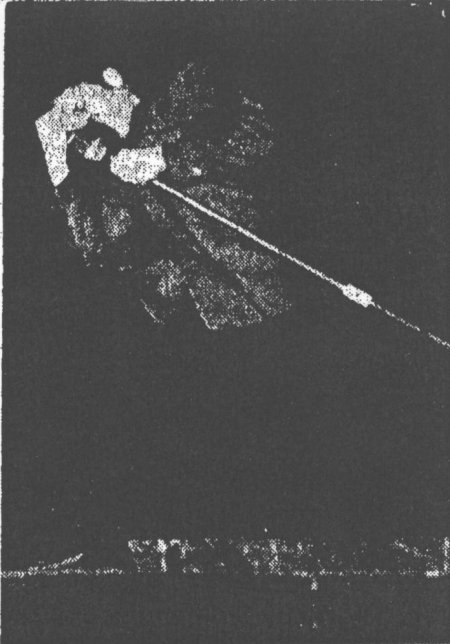
Elvis at the Topeka Municipal Auditorium - May 21, 1956
Daily Capital Photo courtesy Topeka and
Shawnee County Public Library
The Topeka State Journal sent a copy girl to review the
show, apparently, since no one else there appeared interested in
attending. From her they wrote:
 Just a Friendly Fellow This Presley Just a Friendly Fellow This Presley
Buss from Elvis Sou-oooh!-venir of Her Interview
So it turns- out there is a paradise on earth and the elders amongst us,
who spent their happy youth wondering "Who is Sylvia?" have another
quandary to consider.
Namely: Who is Elvis?
The editor around here thought this ought to be put in proper
perspective, which meant he wouldn't budge from his own padded chair to
find out.
NEITHER, it turned out, would anybody else, until the question tickled
thru the ranks to the copy girl.
"Go find out." said the editor, "Who is Elvis?"
The copy girl bounced into the office first thing Tuesday and look out.
here it comes:
"ELVIS," SHE MOANED, "is heaven."
FOR THOSE who prefer a more orthodox doxology, he also is Elvis Presley,
singer.
This young man is running around all over the country charming
teen-agers with his interpretations of rock—and-roll, and it won't do
any good to ask what rock-and-roll is.
The editor tried it. He asked the copy girl, "What is this
rock-and-roll?"
SHE LOOKED bewildered. "Why," she said, "rock-and-roll, that's what it
is."
But whatever it is, it is what the teenagers like in Topeka, where
Monday night brother Presley moaned and groaned and kept 'em screaming.
THE COPY girl joined her contemporaries for this session, but she came
off a little better than the rest of them. She got to interview Elvis.
Funny thing here. When she came into the office Tuesday she flipped her
notes carelessly on the editor’s desk, then went around showing off a
smudge on her cheek.
THAT SMUDGE is where Elvis let her have a big kiss at the end of their
interview, and she's never going to wash it.
Never.
Notes kept by the copy girl transcribe something like this:
Elvis does not need a haircut: that's just the way he always wears his
hair.
He doesn't exactly wear a shirt, but he had on a thing laced across the
front. The copy girl said to be sure to say this wasn't lace. but laces.
There's a difference.
Elvis is just friendly. He just likes everybody. The only reason he has
three Cadillacs is so he can use one on the road and one in his spare
time and have another for his mother and daddy.
SNIDE OPINIONS to the contrary, he is not a hillbilly and he has never
sung hillbilly music and he isn't going to. It's rock-and-roll for him,
until something better comes along.
His description — well whom do you want to believe?
A writer for an out-of-town newspaper said his eyes- were gray—green.
The reporter for another newspaper here said they were blue. The copy
girl said they were, "Oooh!"
SHE ALSO said he had the nicest smile "and all."
Presley appeared at the municipal building Monday night for his contest
with a microphone. When he had finished, according to witnesses, both
the audience and microphone were limp.
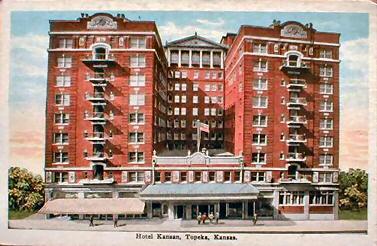
The Hotel Kansan in Topeka
postcard courtesy
Shawnee County Historical society
LEAVING them this way, Presley ducked out of the building and skittered
back to his hotel. All this maneuvering didn't do him any good, because
the copy girl caught up with him again, and so did some other young
women.
So Elvis played host to them all, seating himself on the floor in the
middle of his adorers.
HE TALKED to them about himself and how he thought teenagers liked
rock-and-roll because it was a good outlet for their tensions. This may
or may not be like saying that nervous breakdowns should recuperate in a
boiler factory.
He told them he was sorry he was going to he drafted maybe, because his
singing was going pretty good.
HE TOLD them he didn't wear shirts because sometimes his fans pulled
them off of him'. The Topeka misses were polite. So far as is known,
Elvis did not lose so much as a shoelace here.
The 21-year-old singer from Mississippi has gone now. but he left a
couple of things behind.
ONE OF THEM is the copy girl, who has an autographed picture and that
smudge on her cheek The other is the editor, who still isn’t sure he’s
got the answer to his question.
The Topeka State Journal, May 22, 1956 courtesy Topeka and
Shawnee County Public Library
The following day the band traveled northeast to perform in Des Moines,
Iowa.
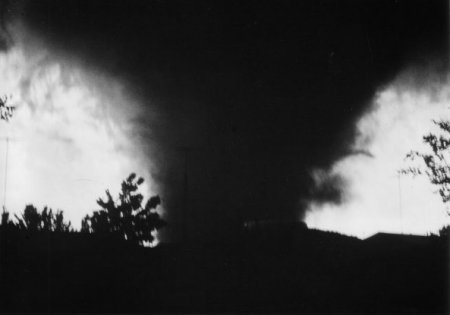
Tornado coming up over Burnett's Mound - June 8, 1966
Kansas State Historical Society photo courtesy
Washburn University
On June 8, 1966, Topeka, Kansas was struck by an F5 rated tornado. It
started on the southwest side of town, moving northeast, passing over a
local landmark named Burnett's Mound. According to a local Native
American legend, this mound was thought to protect the city from
tornadoes. It went on to rip through the city, hitting the downtown area
and Washburn University. Total dollar cost was put at $100 million
making it, at the time, one of the costliest tornadoes in history.4
The auditorium served as a shelter in the aftermath of the tornado.1
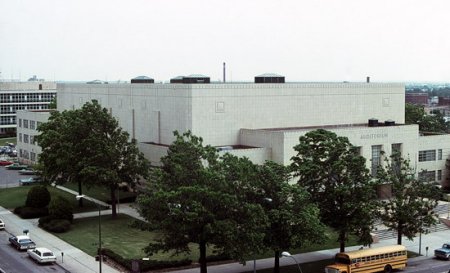
Topeka Municipal Auditorium - 1975
Photo courtesy Grace Muilenburg,
Kansas
Geological Survey
In addition to Elvis, the auditorium's stage was also graced over the
years by Imogene Coca, Fred Waring, Count Basie, and Nat King Cole.
It was the site of town meetings, political speeches and gubernatorial
inaugurations. The multi-purpose facility was also home to basketball
games, circuses, trade shows and Broadway touring companies.1
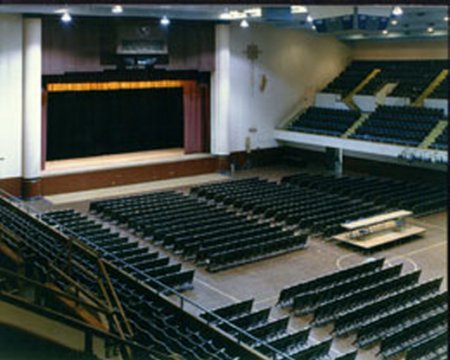
The auditorium - ca.1980s
Photo courtesy the Topeka Performing Arts Center
On September 25, 1987 the Municipal Auditorium featured its closing
performance. It was essentially replaced with the opening of the
Kansas Expocentre earlier that year. That same
year, a task force of private citizens, with the support of Mayor Doug
Wright and City officials, presented a proposal for a $5 million
renovation to convert the existing structure into a state-of-the-art
performing arts center suitable for Broadway touring companies,
world-class orchestras, and major dance companies without departing from
the original Art Deco style. The
City funded $2.5 million, and the balance would be raised from corporations,
foundations and individuals from within the community. The general
contractor for the renovation was Murray and Sons Construction Co., Inc.
of Topeka.1
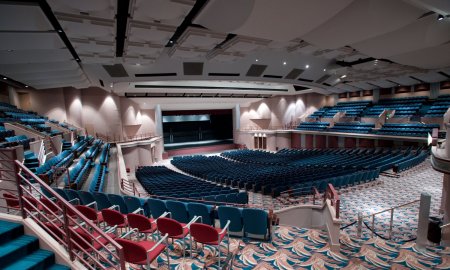
Renovated interior in the Topeka Performing Arts Center
Photo courtesy Erin Aldridge and the Topeka Performing Arts Center
Renovation was completed in the spring of 1991 at a final cost of $6.25
million and included many treated surfaces designed to create "clear
sound" throughout the hall, acoustic clouds (suspended geometric ceiling
sections) and fluted walls. The new shape of the performance hall includes
curved loge seating, a curved balcony section, a sloped floor
and improved sightlines. The new Topeka Performing Arts Center opened
March 23, 1991, with "On Broadway" featuring Ben Vereen and Judy Kaye
and crowds of 2,500 at each of two performances.1
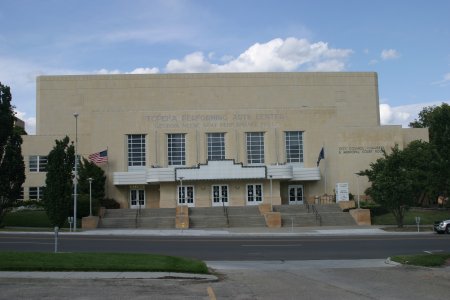
The Topeka Performing Arts Center (and City Hall) - Sep. 25, 2009
The orchestra pit still has an orchestra lift, a large elevator floor
that can be raised or lowered to create different levels within the
orchestra pit. The lift is original to the Auditorium and was used to
raise the circus elephants from their holding area in the basement, and
can still be lowered to the basement for loading of scenery,
instruments, or costumes to the stage level.1
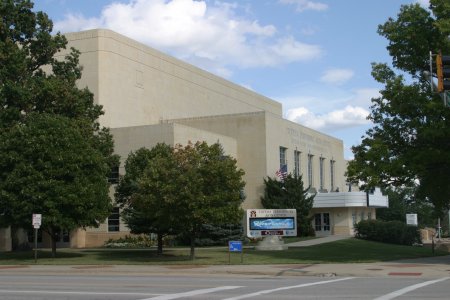
The Topeka Performing Arts Center (and City Hall) - Sep. 25, 2009
In addition to the Performance Hall, three rooms contribute to make TPAC
a state-of-the-art performance hall. The Nunemaker Dance Studio on the
lower level of the facility is a dance rehearsal hall that conforms to
the size of the stage in the main hall allowing dance companies to hold
a full rehearsal to obtain the feel of the stage before the main
performance upstairs. The Hussey Playhouse, a black box theater on the
lower level that seats 120 is used for intimate plays, poetry readings
and experimental theater. The Hill's Festival Hall is the banquet
facility on the lower level used for conventions, wedding receptions and
galas.1
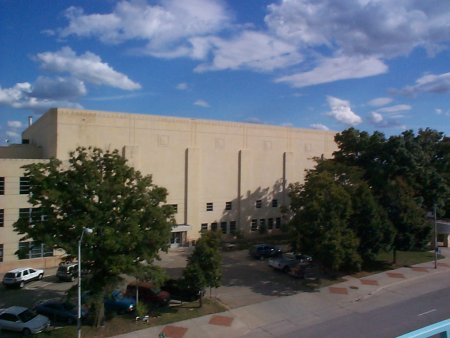
The Topeka Performing Arts Center (and City Hall) - Sep. 25, 2009
Since its reopening, just a handful of the many artists and acts that
have appeared there include B. B. King, Alison Krauss, LeAnn Rimes and
Jerry Seinfeld.1
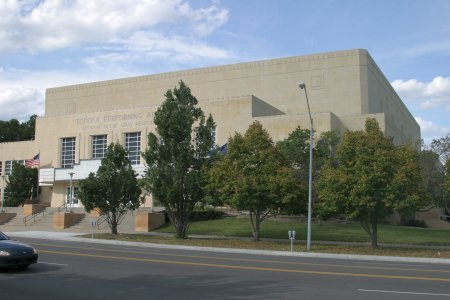
The Topeka Performing Arts Center (and City Hall) - Sep. 25, 2009
The building also still houses the City offices.
page added October 19, 2009
Special thanks to Brad Allen,
Susan Marchant and Brea Black of the Topeka and
Shawnee County Public Library for their assistance with photos and
all articles and ads and to Erin Aldridge, Marketing Manager
of the Topeka Performing Arts Center
for the use of photos.
1 excerpts from and
according to TPAC History courtesy of the
Topeka Performing Arts
Center
2 excerpts from 1950s
Topeka Municipal Auditorium Brochure courtesy of the Topeka and
Shawnee County Public Library
3 from "Elvis Presley Rocks Topekans"
by Anna Mary Murphy, The Topeka Daily Capital - May 22, 1956
4 excerpt from
Wikipedia
This week I received email from a fan that was in attendance at the show
in Topeka and thought I'd share her story here and that of her friend on
another page:
You have delightful coverage of Elvis' 1956 concert in Topeka, Kansas on your Scotty Moore website. I was a kid in the audience that night in May and of course loved what I saw and heard!
I still remember my conservative mom in the audience that night, and I never saw her so excited about a performer! Elvis created quite a stir.
I was nine years old when my mother, who worked for the Topeka newspaper, heard about the Jordanaires coming to town. We decided to attend, and when "the rest of the show" got underway we figured we'd probably have to run to make the bus because the hour was late. Informed teenagers sitting next to us in the audience cried "no, you HAVE to stay to see Elvis!" so we decided to stay for at least his first number. I remember peeking over to see Mom's reaction, and never saw my very conservative mother so excited about a performer! Like folks of every age, we were hooked on Elvis. Going home after the concert, I asked for Christmas gifts to be records of the songs he performed that night like Heartbreak Hotel and Hound Dog, and wore out those 45s on my child's RCA Alice-in-Wonderland record player.
After my mom saw him, she defended him to her also-conservative friends saying something along the lines of "remember how gentle and kind he is to his mother."
A friend of mine here in Lake Oswego, Oregon was a little red headed girl of about 13 on August 29, 1957 when she boarded a train in Chester, Montana --
the same train with Elvis as a passenger that day. She heard that Elvis was on board and asked where he was on the train, went there, and Elvis invited her and a couple girlfriends traveling with her to come in and say hi. After a brief chat (had they seen his movie Love Me Tender etc), one girl apparently asked for his comb, and he gave it to her, and then he took out a necktie and gave it to my friend. The other two teenagers predictably wanted a tie too, so Elvis turned to a buddy (I've wondered and kind of assumed after hearing her tell the story that was possibly Scotty) and asked for his pocket knife, cut the tie into three pieces, and autographed them.

Karen's friend Dotty Holm with the autographed
tie given to her by Elvis in 1957
Photo © Karen Dill Bowerman
We'll be looking for a photo of Elvis wearing that tie when we're in Memphis later this month, and maybe even a photo of him leaning out of that train as he did when departing some stations (including one at Cut Bank, Montana when the girls apparently waved with him).
We are thinking that for her grandkids and posterity in general, she
should authenticate Elvis' signature on her tie section. I was thinking
about one of those guys in Florida like Roger Epperson who authenticates
sigs for a living. Is there a better way to go about that?
Well, I guess that goes to show how many people are drawn together by sharing ways that Elvis' path crossed their own.
Thank you,
Karen
September 2, 2013
Karen Dill Bowerman, Ph.D.
Lake Oswego City Councilor
Lake Oswego, OR 97034
Actually, I think they don't have to go further than another
page on this site for a photo of Elvis with that tie. See more
photos and read what else Dotty has to say
here.
section added September 4, 2013
|


















 "He puts everything into it," is the way a Hayden High senior girl aptly explained it.The initiated comes away in awe that this ex-trunk driver's records sell by the millions without benefit of visual aids.
"He puts everything into it," is the way a Hayden High senior girl aptly explained it.The initiated comes away in awe that this ex-trunk driver's records sell by the millions without benefit of visual aids.
 Just a Friendly Fellow This Presley
Just a Friendly Fellow This Presley









